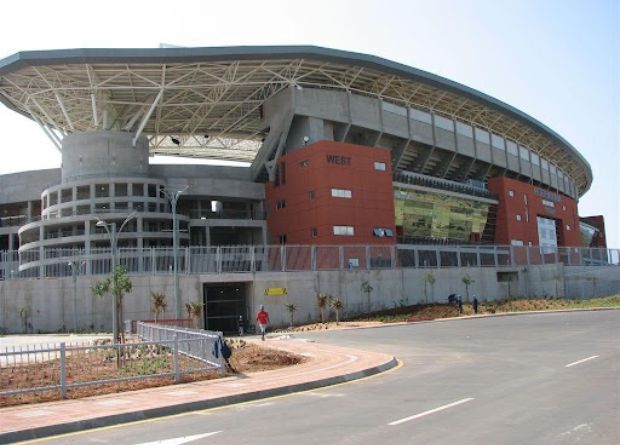Peter Mokaba Soccer Stadium is a magnificent stadium located in Polokwane, South Africa. It was built specifically for the 2010 FIFA World Cup and has a seating capacity of 45,500. The stadium’s construction was a massive project that involved a lot of architectural design and construction techniques.

The stadium’s architectural design is a unique blend of modern and traditional African design. The roof of the stadium is shaped like a traditional African hat, which is a symbol of the region’s culture. The stadium also features a unique lighting system that illuminates the stadium with different colours, giving it a unique and vibrant look.
The construction of the Peter Mokaba Soccer Stadium was a massive undertaking that required a lot of technical expertise and skill. The stadium’s construction techniques were designed to ensure that the stadium was durable and could withstand the harsh weather conditions of the region. The stadium’s construction team used high-quality materials and advanced construction techniques to ensure that the stadium was of the highest quality.
Key Takeaways
- The Peter Mokaba Soccer Stadium has a unique blend of modern and traditional African design.
- The stadium features a unique lighting system that illuminates the stadium with different colors.
- The stadium’s construction techniques were designed to ensure that the stadium was durable and could withstand the harsh weather conditions of the region.
Architectural Design

Stadium Layout
Peter Mokaba Soccer Stadium has a unique architectural design inspired by the local iconic Baobab tree, which is indigenous to the region. The stadium is a bowl-shaped structure that is divided into four main sections, namely the north, south, east, and west stands. The stands are tiered, with the upper tiers being covered by a cantilevered roof. The stadium’s layout offers convenient access, parking, and circulation for supporters attending both football and rugby fixtures, as well as for groups gathering for concerts and rallies.
Seating Capacity
The stadium has a seating capacity of 45,500, making it one of the largest stadiums in South Africa. The seating arrangement is designed to offer an unobstructed view of the pitch from every seat in the stadium. The seating is arranged in a way that creates a vibrant and exciting atmosphere during matches.
Roof Structure
The stadium’s roof structure is made up of a steel frame that supports a membrane roof. The roof is designed to provide shade and protection from the elements while allowing natural light to penetrate the stadium. The steel structure is gathered together at each corner of the stadium and supports the roof plane. The roof is supported by a series of cables that are anchored to the steel frame, creating a tensile structure that is both functional and aesthetically pleasing.
In conclusion, Peter Mokaba Soccer Stadium’s architectural design is unique and inspired by the local Baobab tree. The stadium’s layout, seating capacity, and roof structure are designed to provide an unobstructed view of the pitch, shade and protection from the elements, and a vibrant and exciting atmosphere during matches.
Construction Techniques

Foundation and Materials
The Peter Mokaba Soccer Stadium was built on a concrete foundation with a steel structure supporting the roof, which is covered with Rye Grass and Desso GrassMaster. The stadium’s design is based on the iconic Baobab tree, with each corner of the edifice supported by enormous ‘trunks’, where the steel structure holding up the roof is anchored. These ‘trunks’ cleverly hold lift shafts and spiral ramps.
Sustainability Features
The construction of the Peter Mokaba Soccer Stadium boasts some of the most technologically advanced techniques and operational systems available. The stadium features a rainwater harvesting system that collects and stores rainwater from the roof, which is then used to irrigate the pitch and flush the toilets. The stadium also has a solar water heating system that provides hot water to the changing rooms and other areas of the stadium.
Safety Systems
Safety was a top priority during the construction of the Peter Mokaba Soccer Stadium. The stadium has a state-of-the-art fire detection and suppression system that includes fire alarms, smoke detectors, and sprinklers. The stadium also has an advanced security system that includes CCTV cameras and access control systems to ensure the safety of the spectators and staff.
Overall, the Peter Mokaba Soccer Stadium is a modern and sustainable sports facility that was built using advanced construction techniques and safety systems.
Also, check: Construction Features Inside Cape Town Stadium
Frequently Asked Questions

What are the distinctive architectural features of Peter Mokaba Stadium?
Peter Mokaba Stadium is designed to resemble a traditional African pot, with a unique and striking roof structure that is shaped like an upside-down calabash. The roof is made of steel and is designed to protect the spectators from the sun and rain, while also allowing natural light to enter the stadium. The stadium also has a unique lighting system that is designed to create a vibrant and exciting atmosphere during night matches.
What is the seating capacity of Peter Mokaba Stadium?
As of 2024, Peter Mokaba Stadium has an official seating capacity of 41,733 for football matches. The stadium has a total of four stands, each with two tiers of seating. The stands are named after the four cardinal directions: North, South, East, and West.
Who were the main contractors involved in the construction of Peter Mokaba Stadium?
The main contractor for the construction of Peter Mokaba Stadium was Grinaker-LTA, a subsidiary of the Aveng Group. The project was overseen by the Limpopo Provincial Government and was funded by the South African government.
How does Peter Mokaba Stadium’s construction compare to that of Moses Mabhida Stadium?
While both stadiums were built for the 2010 FIFA World Cup, they differ in terms of their architectural design and construction. Moses Mabhida Stadium, located in Durban, features a unique arch that spans the length of the stadium and supports the roof. Peter Mokaba Stadium, on the other hand, features a more traditional design with a calabash-shaped roof.
What was the total cost for the construction of Peter Mokaba Stadium?
The total cost for the construction of Peter Mokaba Stadium was approximately R1.3 billion (USD 87 million). The stadium was built as part of South Africa’s preparations for the 2010 FIFA World Cup.
What major events have been hosted at Peter Mokaba Stadium since its opening?
Since its opening, Peter Mokaba Stadium has hosted a number of major sporting events, including the 2010 FIFA World Cup, the 2013 African Cup of Nations, and the 2014 African Nations Championship. In addition to sporting events, the stadium has also been used for concerts and other cultural events.



